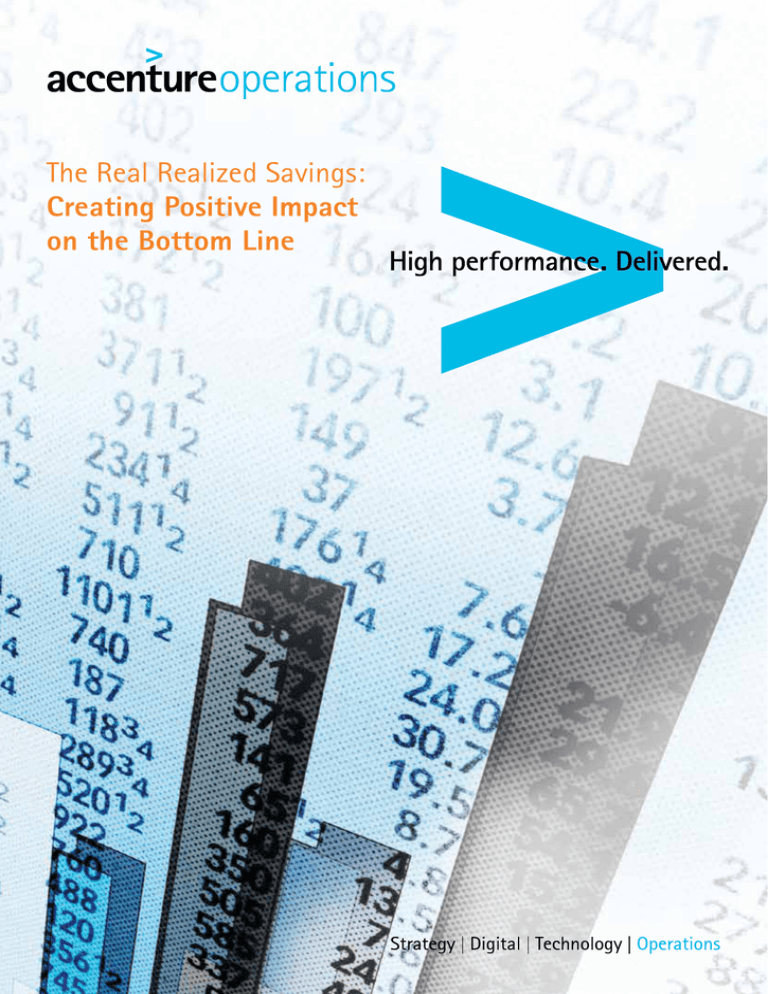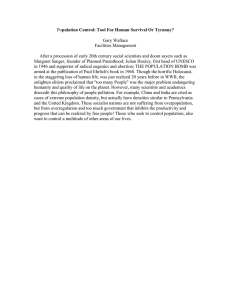
The Real Realized Savings:
Creating Positive Impact
on the Bottom Line
Procurement has
the opportunity to
drive strategic value
through substantial
cost savings, but to
gain credibility with
finance it will need
to close the gap
between real and
identified savings.
Want credibility with finance?
Focus on realized—not
identified—savings
Driving savings is a priority for
procurement. But as companies move to
tackle indirect spend areas, they need
to adopt new techniques to ensure that
savings are actually delivered, plugging
the leakage between sourcing and
spending. Just as market intelligence is a
critical requirement for procurement to
gain credibility with business stakeholders,
this new focus on realized savings,
and developing the skills to deliver and
measure those savings, is the path to
credibility with finance organizations.
What exactly is realized savings? The
term “realized savings” has become a hot
topic in business conversations. Many
organizations say they are delivering it,
while finance is still asking, “Where is
it?” There seems to be a fundamental
disconnect between these two groups.
Procurement typically claims savings at
the point that they are negotiated, while
finance is looking to see how much of the
contracted savings are actually captured
and can be applied to the bottom line.
The latter represents true realized
savings and requires measurement after
spending occurs. This disconnect between
contracted and realized savings is the gap
that procurement organizations need
to close.
With both the imperative and the desire
to deliver more strategic and bottom-line
impact, forward thinking procurement
leaders are raising the bar by putting more
scrutiny on how they measure savings.
Although there is real organizational value
in avoiding cost increases, driving supplier
innovation, reducing supply chain risk, and
driving supply chain efficiencies, leaders
2
know that these efforts alone are not
enough. They know they need to be able to
demonstrate that real-dollar savings have
been captured by the procurement process.
However, our experience with global
procurement organizations shows that
focusing on hard-dollar savings is not the
answer either.
As many companies have experienced,
even hard-dollar savings can disappear
between sourcing and execution. In the
indirect spend arena, savings leakage can
occur in many forms and erode the value
of hard-won contracted savings. Leaders
are taking steps far beyond sourcing
and traditional supplier implementation
to bring those savings home and
measure them in a way that the CFO can
confidently take to the bottom line, or
reinvest in the business.
This paper defines realized savings,
addresses the pitfalls that cause savings
leakage, outlines the most common
savings methodologies, and recommends
steps an organization can take to
establish a realized savings discipline
and infrastructure.
Why realized savings?
The opportunity to deliver substantial
bottom-line financial benefits through
savings in indirect categories of spend is
substantial. Indirect spend can represent
15 percent to 40 percent of revenues
for most companies. In an ideal world,
achieving 10 percent savings on that
spend could yield 1.5 percent to 4 percent
in bottom-line margin benefits. However,
the reality is that most companies achieve
only a fraction of these potential savings.
The level of savings achieved is a function
of four key factors:
Spend managed: The amount of spend
that is managed via a professional
procurement process.
Savings achieved: The level of savings
that are negotiated and contracted.
Savings realized: The amount of those
savings that are actually realized through
compliance management efforts.
Continuous cost improvement:
Incremental savings that can be driven
post-sourcing.
These first two factors are primarily
dependent on market intelligence, the
door opener to the areas of spend that are
often off limits. This intelligence provides
the informational advantage needed
to achieve greater negotiated savings.
Without market intelligence, companies
typically manage just more than half of
their addressable indirect spend and
suboptimize sourcing results.
The third and fourth factors are
dependent on a disciplined approach
and infrastructure to drive and measure
compliance. Once an organization has
established an infrastructure for driving
and measuring realized savings it has a
basis for quantifying and taking credit
for realized savings. It also gains a
platform to assess progress and drive
continuous improvement.
How do leaders drive 90 percent savings
realization? It starts with the right
definition and orientation on realized
savings, supported by proactive and
ongoing management and measurement.
Figure 1: High-performing organizations can deliver five times the bottom-line impact of average companies
HIGH-PERFORMING
AVERAGE
Impact on
$200MM of
annual spend
Benchmark*
% spend managed
% savings achieved
% savings realized
% continuous cost savings
BOTTOM-LINE IMPACT
51%
$104MM
7.7%
61%
0.5%
Benchmark*
Impact on
$200MM of
annual spend
93%
$190MM
$8MM
12.8%
$24MM
$5MM
89%
$22MM
$.5MM
3%
$5.5MM
$6MM
$28MM
Source: Accenture [Illustrative example of a Services company with $1B in revenue & ~$200M in indirect spend]
3
Defining realized savings
The Everest Research Institute provides
helpful definitions for identified,
contracted, and realized savings.
Realized savings represents the most
rigorous methodology for counting
savings, and it is the definition that
most finance organizations prefer to use.
However, most companies are not actually
focused on realized savings. Recent survey
data highlights that only 22 percent of
businesses focus on realized savings,
while nearly 70 percent count identified
or contracted savings before spending
has occurred (see Figure 3). The majority,
therefore, thinks that they are driving
realized savings, when in fact they are
booking identified savings that may not
be realized.
Figure 2: Realized savings vs. identified and contracted savings
Savings Type
Description
Identified Savings
Savings potential based on analysis of existing spend base, benchmarks, industry best practices, market
intelligence and category expertise. Identified Savings are measured as the savings identified by this
analysis whether or not those savings are actually delivered.
Post spend analysis, a strategic sourcing and negotiation process results in new negotiated contracts.
Contracted Savings are measured as the differential between the new/re-negotiated contracts vs. the
old contracts over the volume of purchase for that category.
Contracted Savings
Realized Savings
In Realized Savings, savings are not considered valid until spending occurs. Realized Savings are
measured as the difference between the original cost (pre-sourcing cost) and the actual price paid.
Savings are calculated after the transaction is complete.
Source: Everest Research Institute: “Get More From Your Noncore Spend – Realizing Value from Procurement Outsourcing”
Figure 3: When do companies count procurement savings?
When tackling and delivering savings, at what point do you count the savings?
Procurement assesses savings
after sourcing is complete
Procurement collaborates with
finance once sourcing is complete
is complete
Savings are recorded after
spending occurs
Expense is removed from the
budget once sourcing is complete
Not sure
35%
34%
22%
5%
Only 22% of firms measure
realized savings today
4%
0%
5%
10%
15%
20%
25%
30%
Source: Procurement Leaders PLUS, Controlling the Flow: the Challenges of Indirect Procurement
4
35%
40%
Without a dedicated focus on realized savings, initial savings begin to deteriorate and costs creep back up (see Figure 4).
Figure 4: How savings are lost?
COMPLIANCE WITH DEALS
SPENDING
SAVINGS
"LOST" SAVINGS
Sourcing Project
(Savings Identification)
Sourcing Implementation
(Baseline Reduction)
Return to "Business as Usual"
(Expense Creep)
TIME
Source: Accenture
5
Driving savings realization in indirect spend areas
differs significantly from direct spend areas
Relative to direct materials where savings
realization often occurs somewhat
automatically, driving savings in indirect
areas can be far more complex and
challenging. For example, in direct
categories, after sourcing has occurred,
raw materials and components are
often loaded into a bill of materials and
auto-replenished based on forecasts and
demand plans. Thus, once contracted,
the path from contract to spending and
savings realization is fairly direct with
relatively few opportunities for
savings leakage.
In most indirect spend categories there
can be a numerous points of leakage,
making it much more challenging to
achieve realized savings once they are
identified. Consider an indirect expense
category like travel. The buyer base
(for example, thousands of traveling
employees from across the organization)
is highly fragmented—multiplying the
opportunities for noncompliant spending.
These travelers may deliberately choose
to use their favorite airline carrier rather
than a preferred carrier. Or policies may
not be well communicated or enforced,
leading employees to inadvertently use
non preferred suppliers due to a lack of
awareness of policy. Problems can also
arise on the supplier side where pricing
discounts may not be properly
applied, and individual buyers are not
well equipped to monitor supplier
price compliance.
All of these factors combine to highlight
the potential for savings leakage in
indirect categories. Alternatively, with
end-to-end alignment on driving realized
savings, procurement, finance and the
rest of the organization (HR, operations,
etc.) can create a corporate culture and
supporting policies to minimize points
of savings leakage. This example also
reinforces that counting savings at the
point of contracting is premature—
realized savings can differ materially
from identified savings.
Figure 5: Savings leakage erodes realized savings
IDENTIFIED SAVINGS
REALIZED SAVINGS
Inadvertent use
of nonapproved
suppliers
Source: Accenture
6
Policy poorly
documented/
not enforced
Noncompliant
supplier pricing
Maverick
purchases by
employees
Types of savings methodologies for measuring
realized savings
With the indirect spend opportunity
established, and with an understanding
of the complexities of managing indirect
spend, the next step is to explore the
methodologies used to manage spend,
and to measure realized savings.
Figure 6 outlines five commonly used
savings methodologies, or ways of
measuring and counting actual savings
realized. The most obvious example is
baseline price where savings are measured
based on achieving an actual reduction in
the price paid for a specific item sourced
on a recurring basis.
Note that these savings methodologies
all relate to forms of hard-dollar savings.
It is important to note that these savings
can still be claimed after contracting.
If delivering true realized savings is the
goal, these calculations must be applied
to actual spending data. How a company
chooses to measure spend will have a
large impact on how procurement and
finance teams work together to
drive savings.
methodology so that procurement and
finance are speaking the same
language and are accountable to the
same standards.
The key takeaway is that procurement
and finance need to align on which
savings methodologies will be used to
quantify value for which categories, and
when. Procurement only gets credit for
value delivered, and demonstrating this
value requires a new orientation around
realized savings. Leading companies
measure savings after the point of spend.
It is critical to gain alignment on savings
Figure 6: Savings methodologies
Savings
Methodology
Description
Application/Example
Calculation
Baseline Price
Achieving cost reductions on
recurring spend items with consistent specifications and known
baseline prices
Minimizing the mark-up above
product cost, or for services,
minimizing the mark-up paid
above base labor cost
Measured by comparing the
price paid to published list
pricing, aiming for the largest
discount from list price possible
Achieving a lower rate for a
specific bundle of services based
on insight into overall market
rates and rates for specific roles
and services
Recurring items are identified baseline
price (i.e. general industrial or
electrical supplies)
(Baseline Price-Current
Price) * Current Volume
Services like temporary labor
(i.e. minimum base wage+mark-up)
& value-added products
(Historical Markup
%-New Markup %) *
Current Spend /
(1+New Markup %)
(New Discount %-Old
Discount %)* Current
Spend / (1-New
Discount %)
(Baseline RateNegotiated Rate)*
Current Volume
Cost Plus Markup
Discounted List Price
Rate Reduction
Market Basket
Source: Accenture
Savings measured based on
achieving price reductions
against a representative basket
of items (used to represent
a larger basket of recurring
purchases, but where individual
items may be too small to
track individually)
Products/Services with published list
prices (i.e. software, electronics
components)
Professional services like consulting
or audit
Large baskets of low-dollar items such as Current MB Spend*
office supplies or commercial print
(BCS %/(1-BCS %)
7
Achieving realized savings—five key enablers
How do leaders drive realized savings and
what are the critical success factors for
creating a realized savings culture
and capability?
Alignment and accountability: The
first step to achieving realized savings is
ensuring that there is alignment between
procurement and finance on how savings
will be measured and counted. Getting
all key players aligned on measuring
realized savings is critical to achieving
the cultural shift that will help prevent
savings leakage. In addition to alignment
on realized savings, procurement and
finance must agree on what savings
methodologies will be employed, and who
will be responsible and accountable for
measuring and validating savings.
Stakeholder engagement: At this stage
it is also important to seek alignment
with finance on what will happen to
realized savings. For example, will
some, or all, of the savings in marketing
spend be given back to the marketing
department to redeploy, or will realized
savings result in a new baseline
spend level and lower budgets going
forward? Our recommendation is to
allow for at least a portion of savings
to be reinvested in growth initiatives
to help align stakeholder incentives
with overall savings goals, but this is a
company-specific decision. In addition,
as an organization aligns on savings
methodologies and accountability, it is
imperative to engage stakeholders as
the primary decision makers in each and
every sourcing initiative and ensure that
they are fully supportive of the outcomes.
Engaging stakeholders in the development
of policies and processes will help control
spending and drive compliance. Excluding
them from the beginning can result in
mild resistance, such as stakeholders
seeking out their own alternatives, or
outright sabotage.
8
Awareness and access: Once new or
revised agreements have been put in
place, all stakeholders need to know how
to access these agreements and operate
within established policies. This involves
working closely with stakeholders and
suppliers to execute detailed, categoryspecific implementation plans. These
plans will vary in design depending on
the category but should involve detailed
communication and training activities, as
well as relevant system integration and
process automation activities.
Proactive monitoring and management
at the purchase order level: Once
agreements have been put in place and
fully communicated and implemented,
it is crucial to establish a proactive
monitoring capability to identify and
stop noncompliant purchases before
they are approved and executed. Some
organizations use a combination of
technology and purchasing specialists
to both stop non-compliant orders and
educate end users (who may not know
they are operating outside company
policies). Organizations also need to
recognize that some circumstances
warrant alternative suppliers and policy
exceptions. It is important to determine
these circumstances, set tolerances and
train purchasing specialists accordingly.
Even in these circumstances, specialists
should capture noncompliance reason
codes and determine if there are recurring
supplier issues or exceptions that need
to be systemically addressed to improve
compliance and supplier satisfaction.
Savings measurement and reporting:
Finally, with finance and procurement
teams aligned on savings methodologies,
communications and training completed,
and proactive monitoring in place
companies should rigorously measure
spend, savings and compliance to identify
opportunities for improvement. The more
detailed the savings and compliance
visibility, the better equipped companies
will be to celebrate successes and
proactively identify and mitigate issues.
Detailed visibility to spend, realized
savings and compliance at a category,
regional and site level allows companies
to pinpoint noncompliance and identify
systemic issues. Further, it provides a
baseline to drive continuous improvement
initiatives and achieve higher levels
of compliance.
Where do I start?
There is a lot to digest as an organization
moves to a realized savings approach.
Consider a phased approach: First, drive
cultural alignment (steps 1 and 2 above).
Second, implement process improvements
and policies to drive savings realization
(steps 3 and 4). Finally, drive the last mile
of savings realization by tackling the
most difficult areas like measurement,
reporting and continuous improvement
(step 5). Some organizations will have the
ability to accomplish the cultural shift,
process improvements and necessary
infrastructure on their own. Others will
need to supplement internal expertise
with external expertise and resources.
Regardless of the mix of internal
development or external resources, the
realized savings journey is well worth the
effort because of the additional value that
can be delivered to your organization.
Conclusion
Procurement has a strategic role to play in helping deliver
realized savings, driving bottom-line financial impact and
supporting the strategic goals of the business. With proper
alignment between finance and procurement, organizations
can increase the reliability of savings achieved and delivered to
the bottom line, rather than seeing expected savings erode
after sourcing and negotiation.
9
10
10
11
11
About Accenture
Accenture is a global management
consulting, technology services and
outsourcing company, with more than
293,000 people serving clients in
more than 120 countries.
Combining unparalleled experience,
comprehensive capabilities across
all industries and business functions,
and extensive research on the world’s
most successful companies, Accenture
collaborates with clients to help them
become highperformance businesses
and governments. The company
generated net revenues of US$28.6
billion for the fiscal year ended
Aug. 31, 2013. Its home page is
www.accenture.com.
Copyright © 2014 Accenture
All rights reserved.
Accenture, its logo, and
High Performance Delivered
are trademarks of Accenture.


